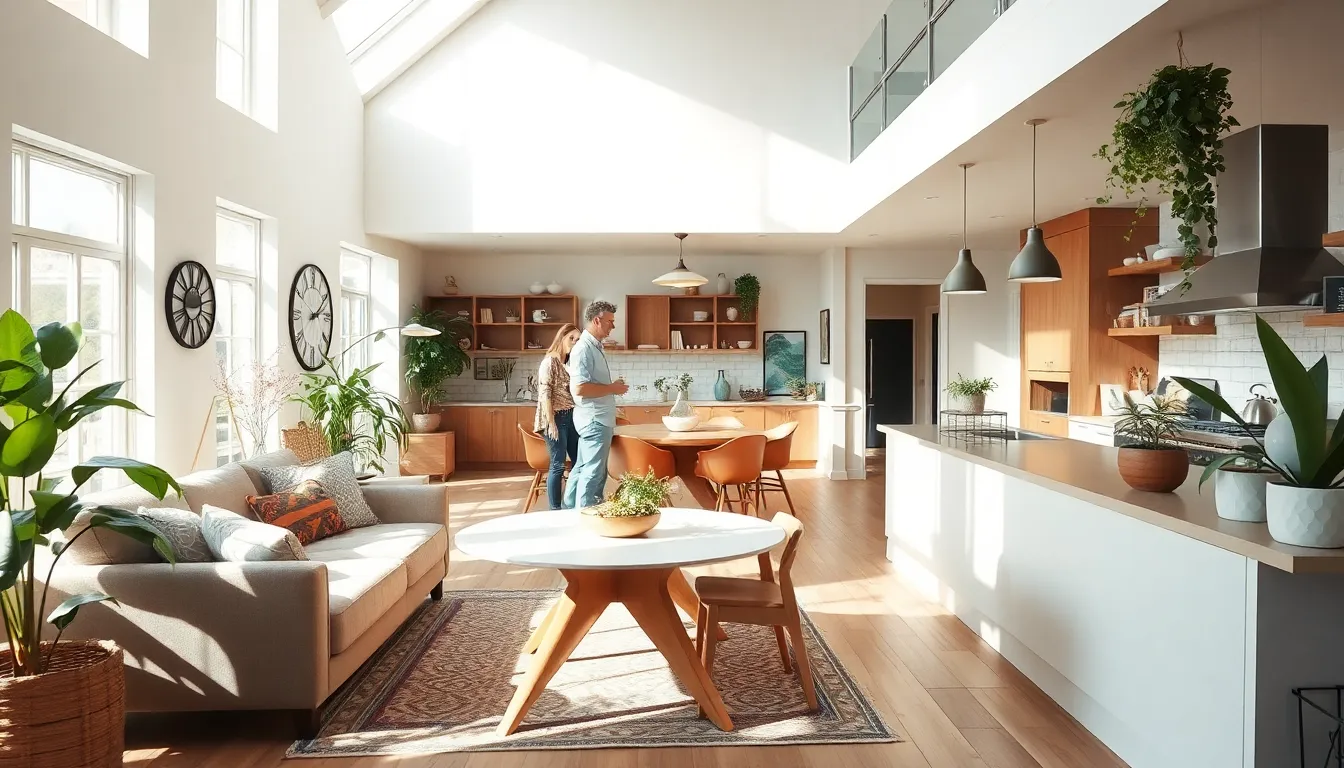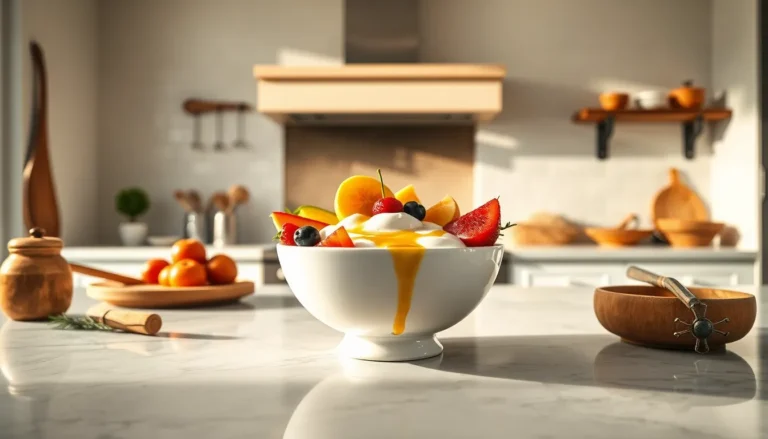Open floor plans have taken the world of home design by storm, transforming how people live and interact. Gone are the days of cramped, compartmentalized spaces that feel more like a maze than a home. Instead, these airy layouts invite natural light to dance across every corner, making even the smallest of homes feel spacious and inviting.
But it’s not just about aesthetics; open floor plans foster connection. Families can cook, entertain, and keep an eye on the kids all at once. Picture this: you’re whipping up dinner while your partner lounges on the couch, and the kids are busy building a fort in the living room. It’s a recipe for togetherness—or at least a great excuse to order takeout when the fort collapses! Dive into the world of open floor plans and discover why they might just be the perfect fit for modern living.
Table of Contents
ToggleOverview of Open Floor Plans
Open floor plans represent a modern approach to home design, prioritizing spaciousness and connectivity. These layouts typically combine key areas such as the kitchen, living room, and dining area into one cohesive space. Homeowners often appreciate the flow between different zones, which encourages interaction and movement throughout the home.
Natural light plays a significant role in open floor plans, as fewer walls allow sunlight to penetrate deeper into living spaces. Bright, airy interiors not only enhance aesthetics but also contribute to a positive atmosphere. Families find that these designs create a sense of togetherness, as occupants can engage in various activities while remaining visually connected.
Many individuals favor open layouts for their versatility. They provide ample opportunities for entertaining guests, as large spaces accommodate gatherings and multiple seating arrangements. Furthermore, parents can keep an eye on children while preparing meals or engaging with visitors, ensuring active supervision without sacrificing social interaction.
Homeowners frequently cite the scalability of open floor plans, allowing for easy modifications or updates in the future. Walls can be added or removed with relative ease, providing flexibility as living needs change over time. This adaptability makes open floor plans a practical choice for various lifestyles, from young couples to growing families.
Open floor plans reflect contemporary living demands, offering a harmonious blend of functionality and style. Their design enhances both social connections and individual interactions, making them a popular option in today’s home market.
Benefits of Open Floor Plans

Open floor plans offer numerous advantages that enhance modern living. They promote a lifestyle centered around brightness, connectivity, and interaction.
Increased Natural Light
Natural light plays a crucial role in open floor plans. Design choices maximize sunlight by eliminating walls and barriers. Spacious layouts invite sunlight to fill interiors, creating a warm environment. Homeowners benefit from reduced reliance on artificial lighting, leading to energy savings. Bright, airy spaces can also improve mood and productivity. Enhanced exposure to natural light highlights design features and creates a more inviting atmosphere.
Enhanced Social Interaction
Social interaction thrives in open floor plans. Combined living spaces encourage engagement among family members and guests. Activities like cooking, dining, and entertaining occur simultaneously, fostering a sense of togetherness. Homeowners can easily supervise children while preparing meals or hosting gatherings. Versatile spaces allow for fluid movement, enabling spontaneous conversations and connections. Open designs support diverse activities, making it easy for guests to mingle and enjoy each other’s company.
Drawbacks of Open Floor Plans
Open floor plans, while popular, come with notable drawbacks.
Noise and Lack of Privacy
Noise levels often increase in open layouts. Sounds from the kitchen can travel into the living room and dining area. Conversations in one zone disrupt activities in another space. Lack of distinct areas limits quiet time, making it difficult for individuals to focus. Privacy decreases as more people inhabit the same space, which may affect personal interactions. In a bustling home, distractions from television, cooking, or conversations become prominent. For those seeking solitude, open designs may not provide the desired environment. Thus, the communal feel can sometimes shift towards chaos, challenging daily activities.
Limited Wall Space
Limited wall space affects furniture placement in open floor plans. Traditional homes often use walls for shelving and artwork. Open designs lack the flexibility for such installations, creating challenges in personalizing spaces. Without walls, homeowners cannot create distinct zones or separate functions effectively. This lack of delineation can lead to clutter, as everything must share the same area. Furthermore, limited wall space restricts storage options, compelling occupants to consider creative solutions. Ultimately, the absence of walls may hinder effective organization and design adaptability in the home.
Popular Design Trends
Contemporary open floor plans incorporate a variety of design trends. Neutral color palettes dominate many spaces, contributing to a cohesive aesthetic. The inclusion of natural materials like wood and stone enhances warmth and invites a connection with nature. Additionally, integrated lighting solutions, such as recessed fixtures and pendant lights, illuminate key areas without disrupting visual flow.
Smart home technology increasingly plays a role in modern designs. Homeowners prefer features like automated lighting and temperature control, enabling convenience and energy efficiency. Open layouts provide the opportunity for multifunctional spaces, which seamlessly adapt to different activities throughout the day.
Furniture arrangements also reflect trending preferences. Modular couches and movable dining setups allow for flexibility during gatherings or everyday family life. Sustainable elements, such as eco-friendly furniture and energy-efficient appliances, are gaining traction. These options align with a growing awareness of environmental impact within home building and renovation.
Furthermore, biophilic design principles embrace elements that connect indoors with the outdoors. This trend involves using large windows or sliding glass doors that invite natural light and facilitate outdoor access. Indoor plants are also increasingly popular, bringing greenery inside and improving air quality.
Finally, statement pieces, such as bold artwork or distinctive light fixtures, catch the eye and serve as focal points in expansive spaces. The combination of personalization with functional design creates environments that reflect individual styles while enhancing daily living experiences. Open floor plans thrive on these trends, promoting both style and practicality in modern homes.
Open floor plans represent a significant shift in modern home design. They cater to the evolving needs of families by fostering connection and interaction. This layout not only enhances natural light but also promotes a sense of spaciousness that many homeowners crave.
Despite the benefits, it’s essential to weigh the drawbacks such as noise and privacy concerns. Homeowners should consider their lifestyle and preferences when deciding on an open layout. The key is finding a balance between functionality and personal comfort.
As trends continue to evolve, open floor plans will likely adapt, incorporating innovative design elements that address their challenges while enhancing their appeal. This flexibility ensures that open layouts remain a popular choice in contemporary living spaces.


